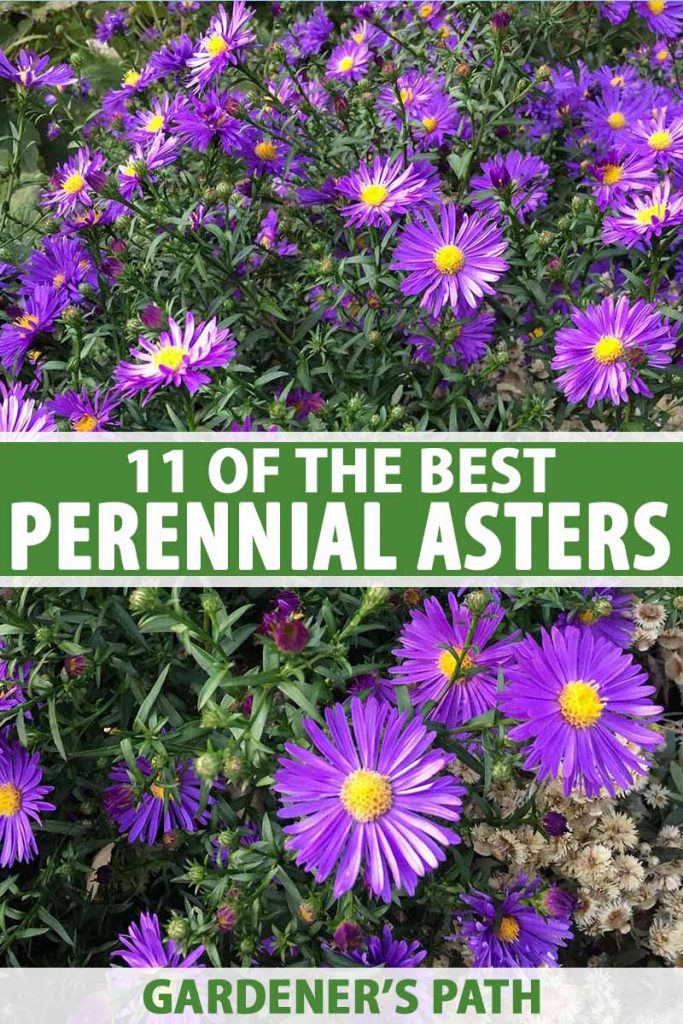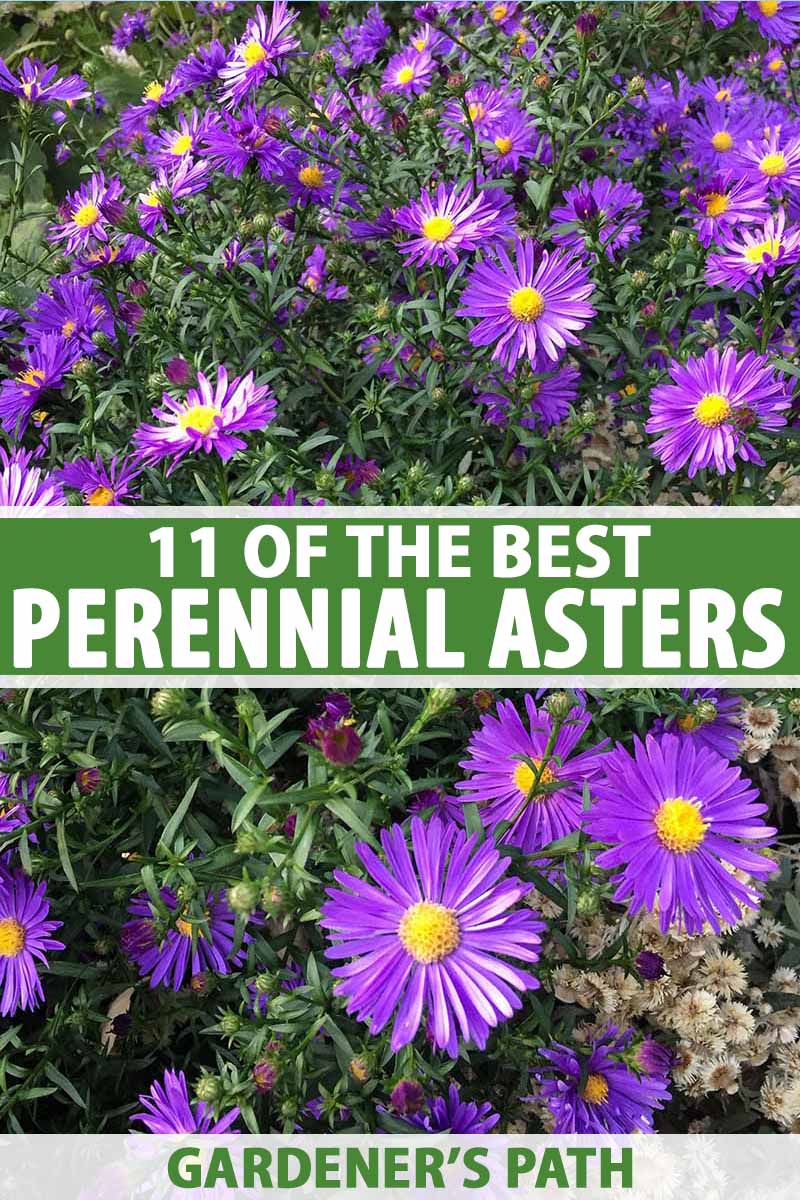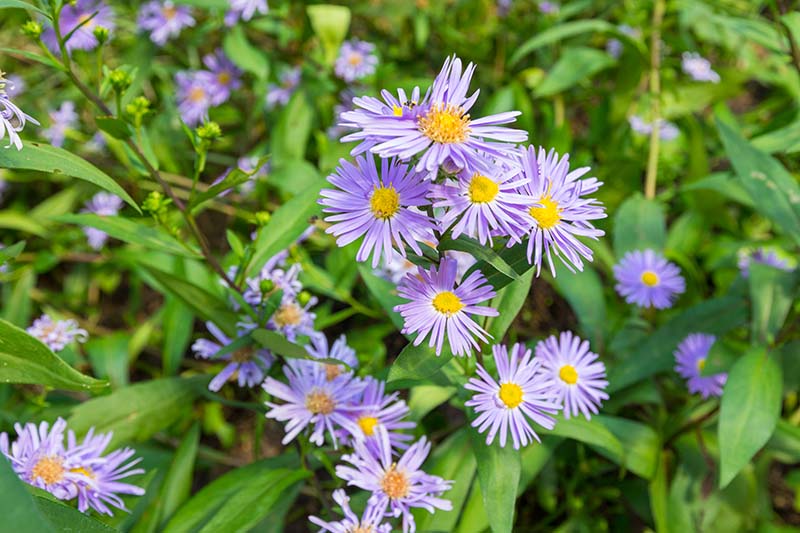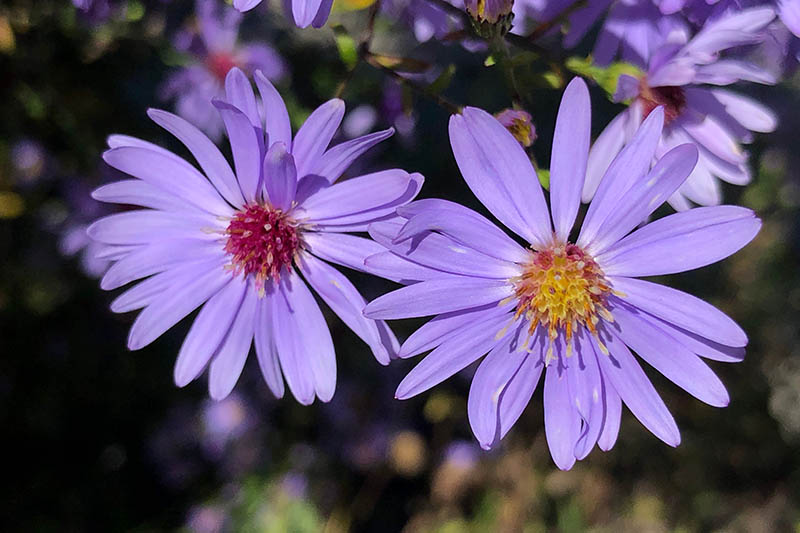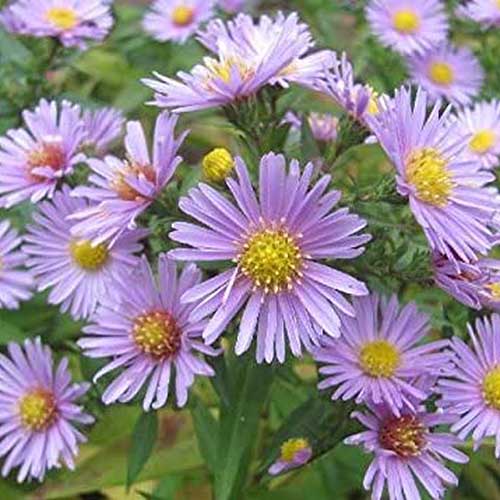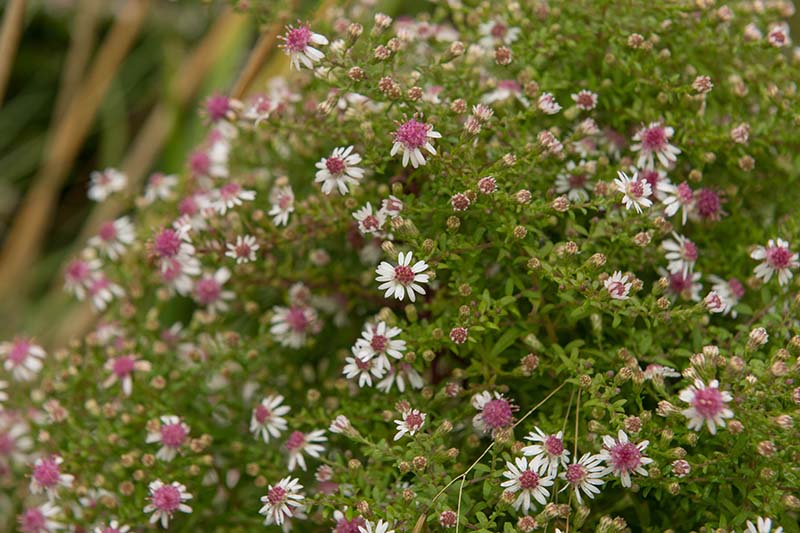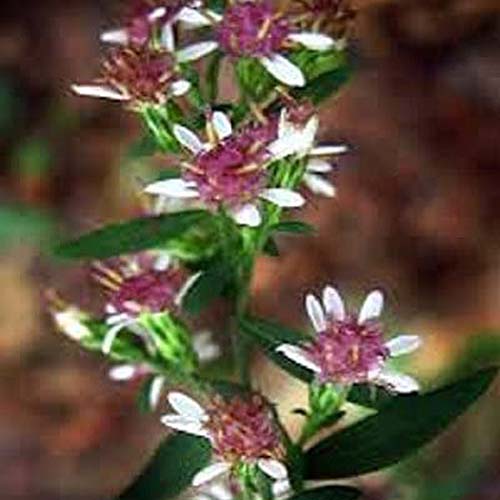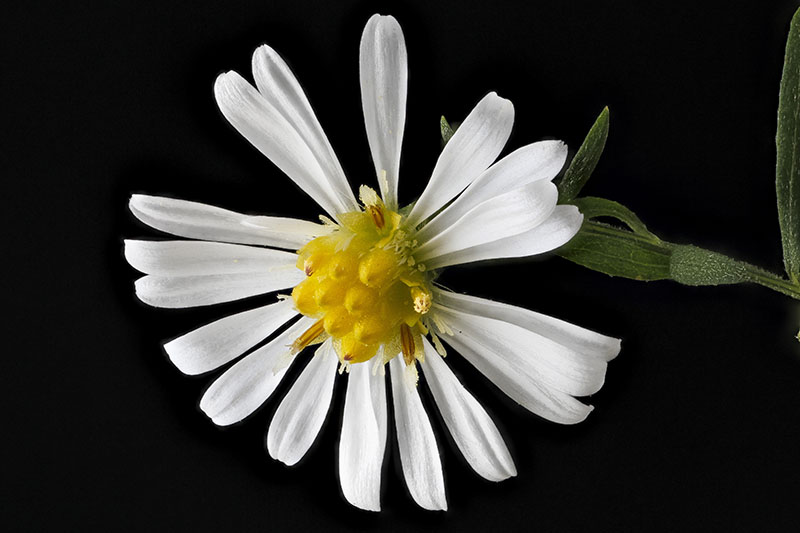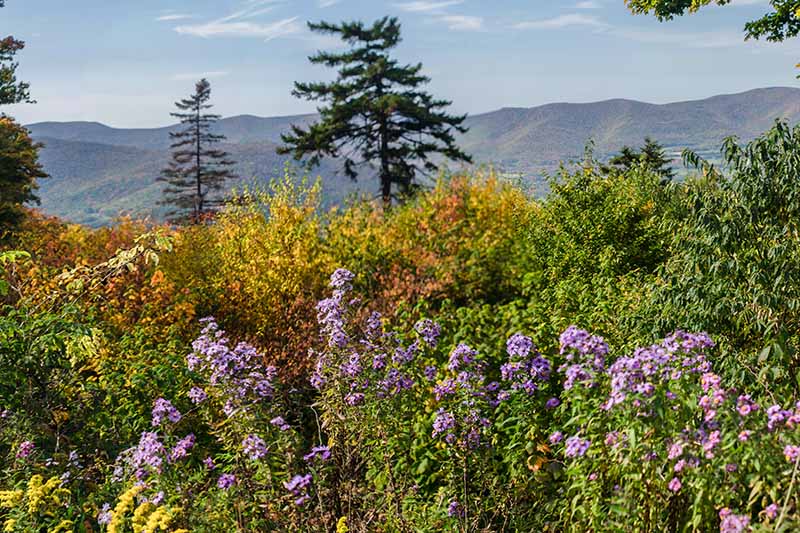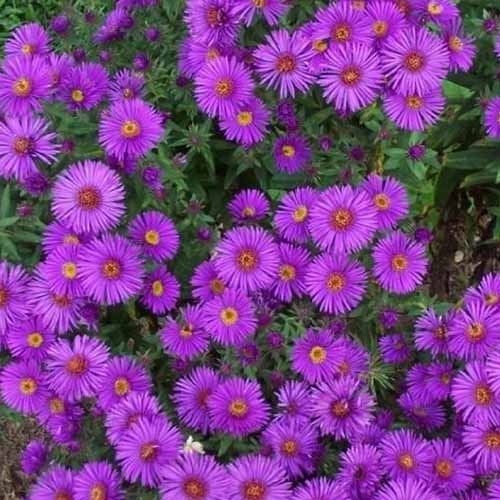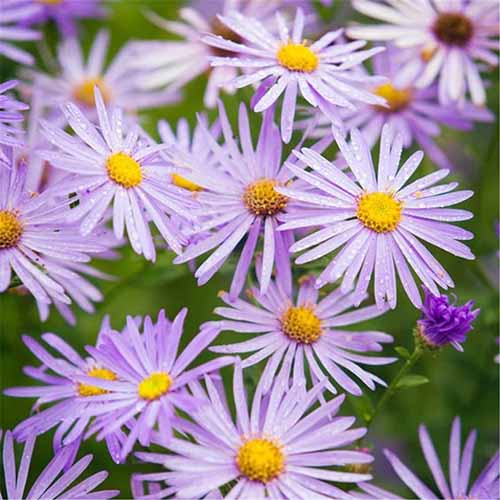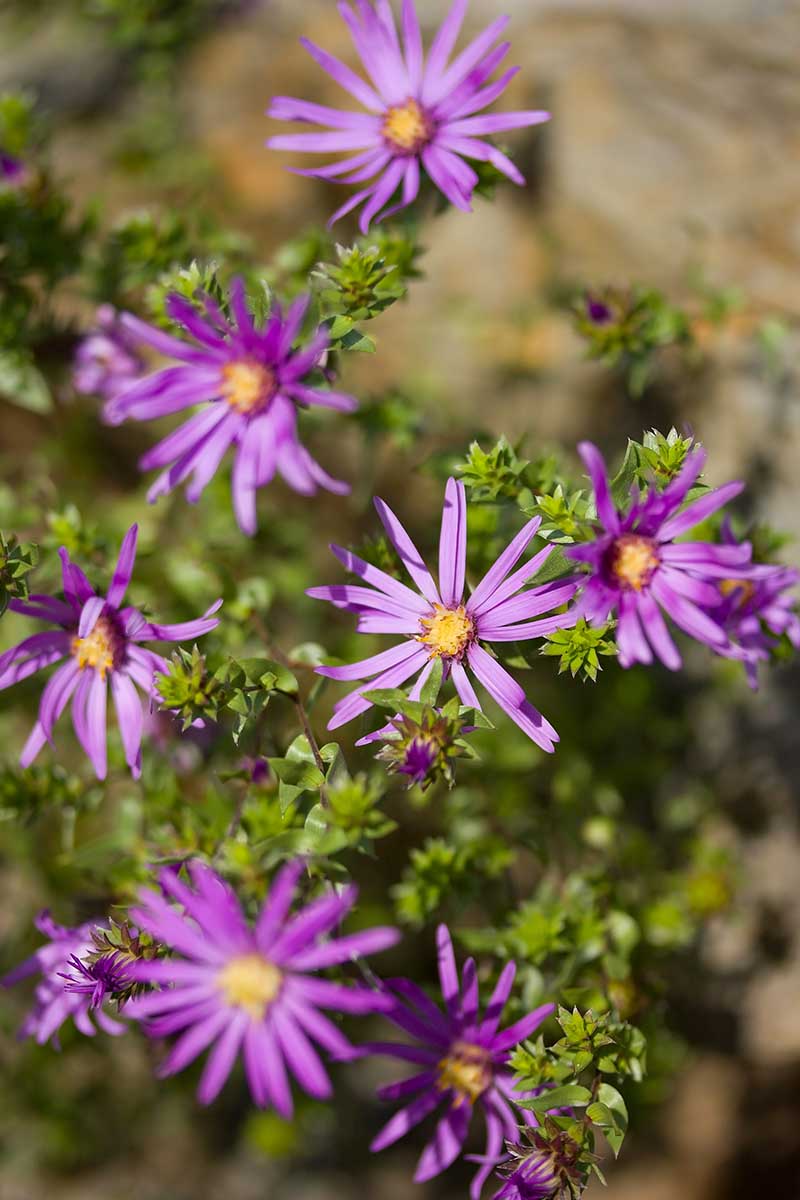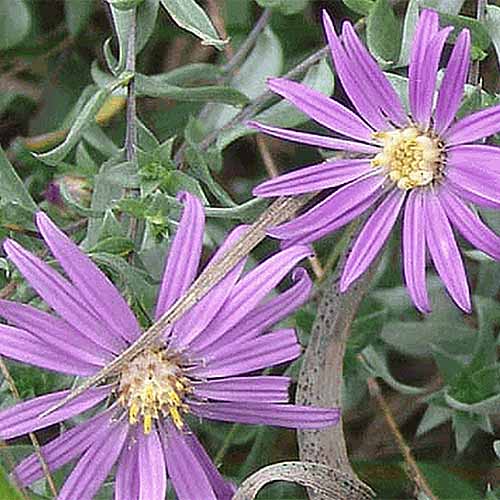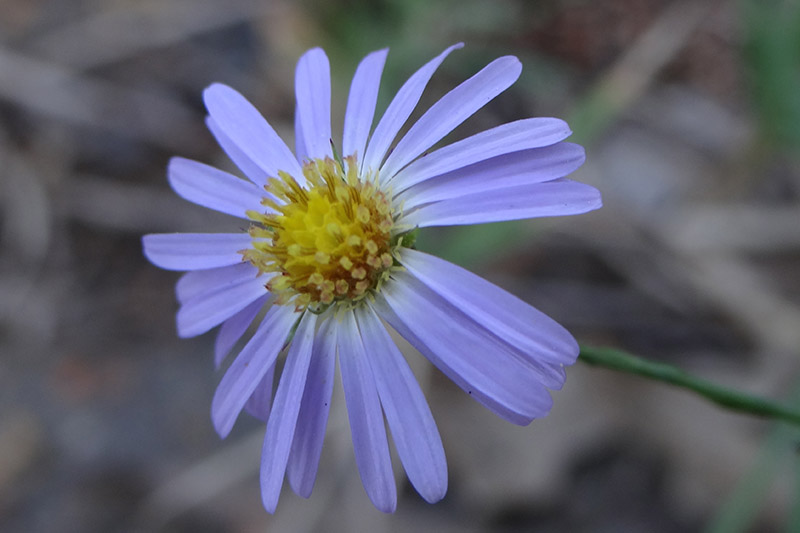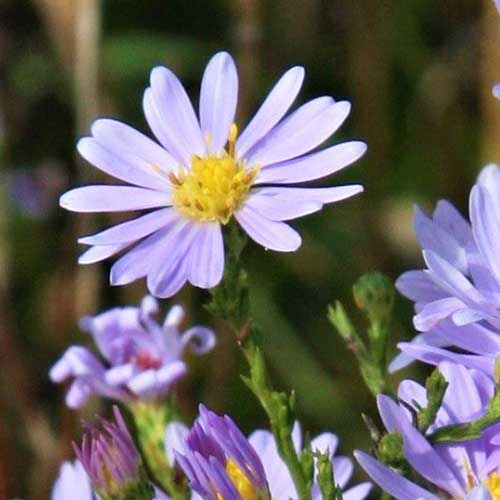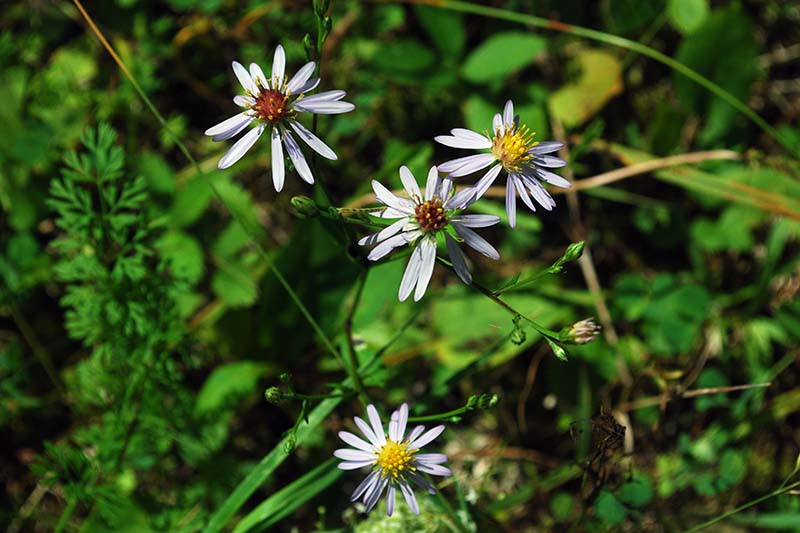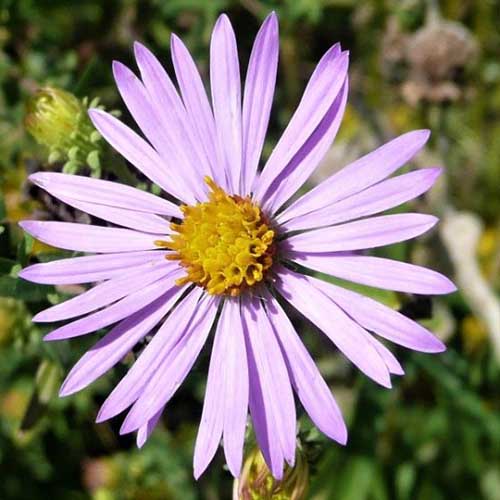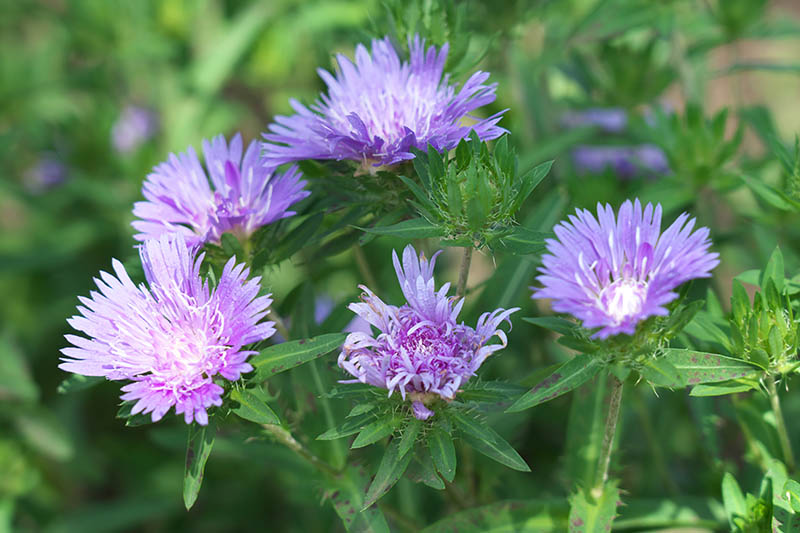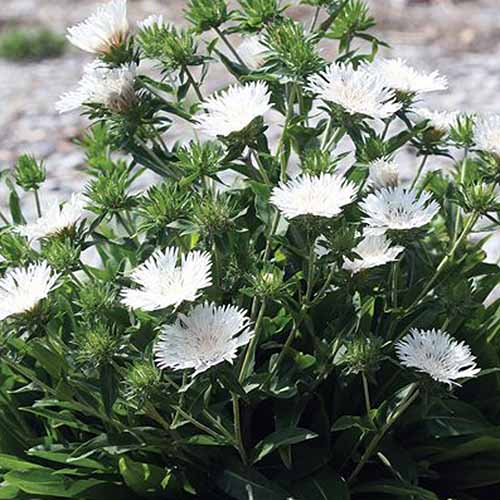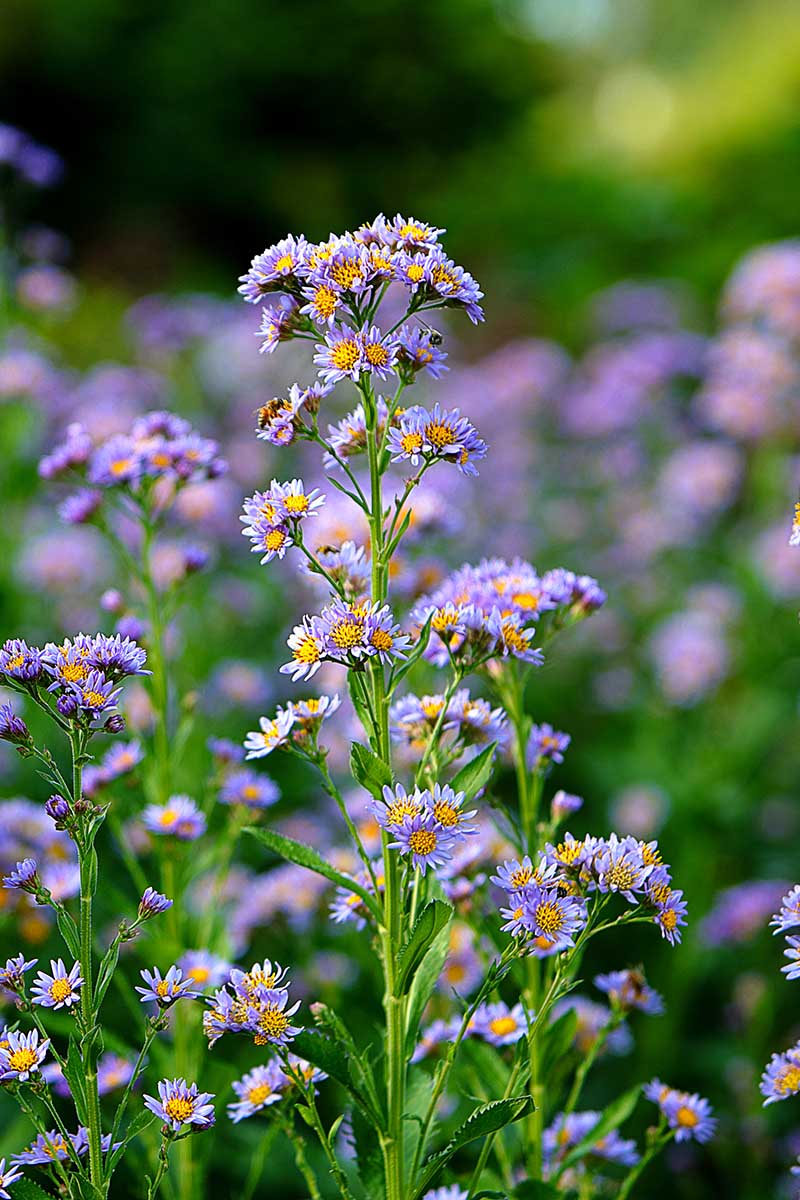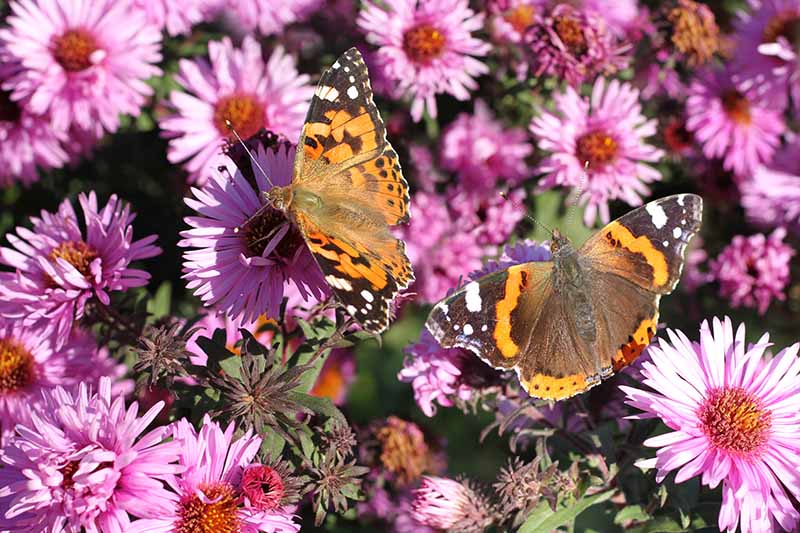They are transition flowers that bloom from late summer into fall in USDA Hardiness Zones 3 to 8. There are numerous types available, all with colorful daisy-like blossoms and a shrubby growth habit. We link to vendors to help you find relevant products. If you buy from one of our links, we may earn a commission. The following list highlights the characteristics of 11 of the best perennial aster species.
1. Aromatic
The aromatic aster, Symphyotrichum oblongifolium, is a medium-sized native species with a mature height of one to three feet, and an equal spread.
The plant has a compact growth habit. The stems are stiff and branching, giving it a bushy appearance. The lower portions turn brown and woody in the fall. The leaves may range in color from yellowish to dark green. They have smooth margins and are large at the bottom, becoming smaller near the tops of the stems. When crushed, they give off an aromatic fir-like aroma. The foliage has tiny hairs. The flowers have violet blue rays with yellow center disks. They are approximately one and one-quarter inches across, and are clustered at the ends of the branches. The centers turn reddish purple as they age. Plants thrive in a full sun location, but will tolerate part shade. Soil of average quality is adequate, provided it drains well. Dry soil, sand, and clay are tolerated. Water needs are low to medium. This is an excellent choice for problem areas of the landscape where the soil is dry and eroding. In overly fertile soil, this plant may fail to thrive in competition with other vigorous plants.
2. Blue Wood
The blue wood or heart-leaved aster, S. cordifolium, is a tall native species with a mature height of approximately two to five feet. Widths range from about 18 to 24 inches.
Upright branching stems mature to reddish brown. Atop each stem is a panicle heavily laden with blossoms. This type has a tendency towards “leggy” growth, and generally requires staking. The leaves are prominently serrated and may be covered in sparse hair. Lower foliage is heart-shaped and larger than the upper leaves. They wither and drop by late summer. Blooms have pale to bright blue rays surrounding yellow center disks, and measure about three quarters of an inch across. This plant prefers full sun, but also does well in part shade locations. S. cordifolium Its preference is for organically-rich, moist, well-drained soil, but it also thrives in average soil with dry to medium moisture levels. This tall type is impressive when planted en masse, and naturalizes beautifully in informal wildflower gardens and stand-alone drifts.
3. Calico
The calico or side-flowering aster, S. lateriflorum, is a mid-sized species that generally tops out at about two to three feet tall with an equal spread.
This type has a bushy growth habit. The stems are hairy and mature to red-brown. There is some horizontal branching, and staking may be necessary. The leaves are rough textured and narrow, and may be somewhat hairy. They are larger at the bottom of the plant, gradually becoming smaller towards the top of the stem. The lower leaves may have some serration of the margins. This plant has bronze foliage in fall. The flowers have white rays that may be tinged with purple. They measure one-half to one-third of an inch across. Center disks are yellow maturing to reddish-purple. Blossoms are clustered in upright panicles along the uppermost side of each stem, and this pattern is the reason for the alternate name, “side-flowering.” Plants thrive in full sun to part shade locations. The ideal soil is organically-rich and well-draining. Water needs are low to moderate. Two noteworthy characteristics are that this plant thrives exceptionally well in disturbed soil, such as land that has been uprooted for construction. Also, it is able to tolerate occasional flooding. S. lateriflorum Calico aster makes an attractive showing with some yellow and some reddish-purple center disks, for a mottled – or calico – appearance. It makes a funky back-of-bed anchor behind mid- and low-profile specimens, provided it is staked. Please see our calico aster growing guide for more information.
4. Frost
The frost or hairy aster, S. pilosum, is a native species that grows to mature dimensions of between two and four feet tall and wide. It has hairy branching stems and a clumping growth habit. Sturdy, straight stems darken to brown and become woody. Staking may be required. The leaves are also hairy, with a lance shape and slightly serrated to smooth margins. The leaves at the bottom are larger, and tend to drop off when the soil becomes very dry. The flowers consist of white rays surrounding pale yellow center disks that mature to reddish-purple. They measure three-fourths of an inch in diameter and are loosely clustered at the tops of the stems. This plant grows best in full sun to part shade. S. pilosum Water needs are moderate, and occasional flooding is not a problem for this plant. This wild and wooly kind, which some gardeners refer to as “weedy,” is best planted somewhere that it can spread – such as along a perimeter fence beside a road, where it can serve as both a haven for wildlife and an informal privacy hedge.
5. New England
The New England aster, S. novae-angliae, is a tall native species that tops out at three to six feet tall with a spread of two to three feet. Staking is necessary. Thick, hairy stems grow in an upright, non-branching fashion. Hairy lance-shaped leaves line the stems. Flowers with rays of pink, purple, violet-blue, or white cluster in dense cone-shaped panicles at the tops of the stems. They measure one and one-fourth inches wide and have yellow center disks. Full sun to part shade and organically-rich, well-draining soil are ideal for this type. A moderate amount of water is required.
S. novae-angliae New England asters are best planted in open spaces where they have room to spread, such as in mass plantings along property perimeters, or in dedicated drifts. Find seeds in various packet sizes available from Eden Brothers. Learn more about New England asters in our growing guide.
6. New York
The New York aster, S. novi-belgii, aka Michaelmas daisy, is a native species that reaches heights of three to six feet and widths of two to three feet.
It has an upright growth habit and stems that are thinner than those of the New England species. Given the height of the stems, required staking is to be expected. The leaves are not hairy, like those of the New England type, but smooth. They are gray-green and lance-shaped with slightly serrated margins. Deep pink- or purple-rayed flowers cluster in dense panicles. They have yellow disk centers and measure about one and a quarter inches across. S. novi-belgii Plants thrive in full sun to part shade where the soil is organically-rich and well-draining. They tolerate clay, and have moderate water requirements. This type is very similar to the New England species, and does best in mass plantings in drifts, informal hedgerows, and meadows, where there is room to spread.
7. Silky
The silky or Western silver aster, S. sericeum, is a compact native species that tops out at one to two feet tall and wide.
This plant grows in a compact, clumping style. Its wiry, delicate stems are mostly upright, with some slight branching. They start out green and mature to brown. Leaves are oblong to lance-shaped with smooth margins. Foliage generally withers and drops by the time the flowers appear. Both stems and leaves are covered in fine, silky hair, the basis for this plant’s primary common name. Flowers consist of lavender to purple rays surrounding yellow center disks. They measure about one and one-fourth inches across, and cluster at the tops of the stems. A full sun location and sandy, gravelly soil that drains well are ideal. Water needs are low to average, and this plant has above average drought tolerance. This type bears a close resemblance to the aromatic species, described above.
S. sericeum Good garden placements include the rough soil beside paved areas like driveways and roads, where this informal lower-profile plant won’t impede drivers’ visibility, and there’s room to spread. This type is also suited to container gardening, xeriscaping, and seaside locations. Seeds are available at Walmart.
8. Sky Blue
Sky blue aster, S. oolentangiense, is a native species that grows to a mature height of two to three feet tall. Widths range from 18 to 24 inches. This plant has an upright form with branching stems. Staking may be required. Rough, hairy leaves are oblong to lance-shaped. They are dense and large at the base and get smaller and sparser toward the stem tips, where the flowers are loosely clustered. Blossoms measure about one inch across. They have sparse blue rays and yellow center disks. The shade of blue may vary from deep to pale, or it may be slightly purple. This variety thrives in full sun to part shade, with average to poor well-draining soil. Water needs are low to moderate.
S. oolentangiense An above average tolerance of salt, drought, and rocky or shallow soil make it well-suited to xeriscapes, seaside gardens, rockeries, and locations where erosion is a problem. This plant is endangered in New York State. Find starter plants now from Nature Hills Nursery. Please see our sky blue aster growing guide for more information.
9. Smooth
The smooth or smooth blue aster, S. laeve, is a native species that ranges from two to four feet tall at maturity. It has a spread of one to two feet. With an upright profile and little branching, the stems have a bluish tint, and the upper leaves are very tiny. There is some serration of the bluish-green, oval to lance-shaped leaves. They are exceptionally smooth, hence the name. Blossoms are arranged in loose panicles. Rays in shades of lavender, purple, or white surround yellow centers that mature to reddish tones. They measure about one and a quarter inches across, and are so hardy they often continue to bloom after a frost. This plant prefers full sun and average, well-draining soil. Water needs are low to moderate. Like the sky blue type, this variety has above average tolerance of drought, as well as shallow and rocky soil.
S. laeve This plant does best when there’s no competition from other vigorous growers. It is suited to xeriscaping, as well as rock gardens and the seaside, especially where erosion control is needed. Find starter plants now from Nature Hills Nursery.
10. Stokes’
The Stokes’ aster, Stokesia laevis, is a native species with a compact height of one to two feet, and a spread that ranges from one to one and half feet.
Unlike other species that are suited to USDA Hardiness Zones 3 to 8, this type thrives best in Zones 5 to 9. In addition, it blooms earlier than most, from late spring or early summer to midsummer. With deadheading, it is likely to have a second flush of blossoms in early fall. This plant grows in an upright fashion. It has elliptic to lance-shaped leaves that are large at the base and gradually become smaller as they ascend the stems. The leaves are evergreen in the warmer climates. The flowers are lavender-blue and resemble the bachelor’s button, with feathery rays and no yellow center disk. Cultivated varieties are available in shades of blue, purple, and white. They are also quite large at two and a half inches in diameter.
S. laevis This kind does best in full sun to part shade. It prefers moist, sandy soil, but tolerates average quality, provided the drainage is good. S. laevis is an excellent bedding plant and is ideal for growing in containers. Find seeds now at Walmart.
11. Tatarian
The tatarian aster, Aster tataricus, is native to Siberia. Botanical species may exceed six feet in height, with a spread of one to three feet at maturity.
Sturdy upright stems seldom require staking. The leaves are especially large at the base and can grow up to two feet long, graduating to smaller ones as they near the stem tops. Flowers measure one inch across. They have lavender-blue rays and a yellow center disk. The rays are wide and turn upwards, unlike the narrow, needle-like rays of other types. In addition, instead of clustering in cone-like panicles, they form more of a flat-topped group of blossoms. This kind needs a full sun location, with soil of average quality that drains well. A. tataricus Water needs are moderate, and it exhibits above average drought resistance. Best uses for this self-staking plant include back of border placements, and naturalizing in meadows and stand-alone drifts. You can find more information in our tatarian aster growing guide.
Robust Revelers
In addition to these 11 botanical species, there are numerous cultivated varieties available. Be sure to read descriptions closely, as plants may be smaller and more compact, or have colors that vary from the species as found in nature. Also, if you are a seed saver, know that only seeds from botanical species can be counted on to reproduce an exact replica of the parent plant. Seeds saved from cultivars, particularly hybrids, may yield different characteristics, or they may be sterile. Perennial asters are not your typical showy garden plant, but the combined visual impact of multiple small blossoms makes a bold impact in the garden.
A little bit scruffy, tall plants have a tendency to flop over, and are likely to need staking to keep them upright. I find them particularly attractive along fenced property borders where they can spread at will, and create an ever-enlarging swath of color to block unwanted views. Add to that the teeming beneficial insects they attract, and you’ve got a garden humming with life when warm-weather flowers are fading and there’s a slight chill in the evening air. Now that you’re acquainted with 11 aster species, it’s time to color outside the lines a little, and make room among your well-behaved plants for a few wild ones that love to let their hair down and glory in the waning summer days. Are you growing perennial asters? Let us know in the comments below, and feel free to share a picture! And for more information about growing asters in your garden, you’ll need these guides next:
How to Grow and Care for Asters 21 Tips for Managing Perennial Asters in the Garden How to Prevent and Manage Aster Yellows When and How to Divide Perennial Asters
